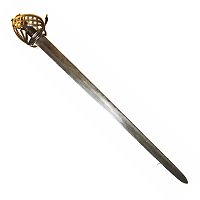Basket sword
| Basket sword | |
|---|---|

|
|
| Information | |
| Weapon type: | sword |
| Designations: | Basket sword, basket hilt sword, basket hilt sword, Schiavona, broadsword |
| Use: | Cavalry and foot troop weapon |
| Creation time: | 16th Century |
| Working time: | 16th to 19th century |
| Region of origin / author: |
England |
| Distribution: | Europe |
| Overall length: | approx. 100 cm, variable |
| Blade length: | approx. 75 cm, variable |
| Blade width: | approx. 7 cm - 9 cm, variable |
| Blade thickness: | approx. 0.45 cm, variable |
| Weight: | approx. 1100 g, variable |
| Handle: | Wood, horn, bone, ivory |
| Lists on the subject | |
The basket sword , also known as a basket sword , is a sword form of the early modern period , which is characterized by a basket-like closed vessel and a wide, straight blade that hardly differs from those of medieval swords .
Form and terminology
Like the rapier or other swords from the period in which they were made, the basket sword has a complex handle basket that protects the hand. In contrast to the rapier, however, the basket sword has a relatively wide blade that is suitable for cutting and stabbing. As a result, surviving specimens are often a little shorter than the rapiers, which are more geared towards the stitch and weigh similar to basket swords.
In this form, the blades show strong similarities with those of medieval swords. Because of the differences to the lighter and thinner weapons of the time, the term broadsword was used in English in the early 19th century . It refers explicitly to these early modern weapons and underlines the difference to the so-called smallsword , a bladed weapon that would be called a sword in German today .
A literal interpretation of the term often leads to the erroneous assumption that a broadsword generally has a blade that is particularly wide, for example compared to those of the high and late Middle Ages . However, this is not true, which is why a literal translation as broadsword can be misleading. With collectors, however, the English name is quite in use, as is the name backsword for basket swords with a single-edged blade.
history
The earliest examples of swords with complex hilt baskets date from the mid- 16th century and are of English origin. Precursors of this form of hand protection individual rings or strap were the parry . Basket swords soon enjoyed growing popularity as military swords and, in different versions, were part of the standard equipment of various troops. They remained in use into the 19th century, in isolated cases even into the 20th century.
From the 17th century onwards a distinction was made between several forms, including the Italian Schiavona , the Scottish basket sword , which, like the older Scottish long sword, is also called claymore , or the warrior sword . The latter was partly single-edged and was particularly common in England in the 17th century.
literature
- Thomas Laible: The Sword - Myth and Reality . Wieland Verlag, Bad Aibling 2006, ISBN 978-3-938711-05-7 .
Individual evidence
- ↑ Clements, John: Broadsword or Broad Sword? Settling the Question of What's in a Name on thearma.org . Retrieved June 20, 2016.
- ↑ Ibid.
- ↑ Sword from Mary Rose on display at www.bbc.com . Retrieved June 20, 2016.